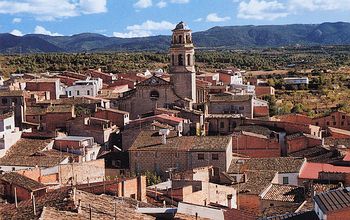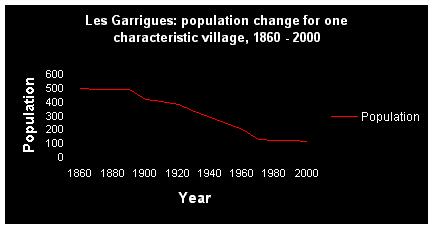Les Garrigues: Rural Depopulation
Three small contrasting villages in the Garrigues, approximately an hour's drive from Barcelona, form the basis for an investigation into the economic, social and environmental impact of rural depopulation in the region. The impact of depopulation in some of the villages is evident in the loss of services, the number of abandoned fields and gentrified second homes. Some villages have suffered more than others, and primary data collection seeks to identify the range of factors responsible.
 |
|
L'Albi - a typical village in the Garrigues region |
The Garrigues region comprises a plateau inclined towards the northwest, bordered to the south by the Catalan Central Depression and to the north by the Urgell plain. The Set is the most important river draining the region where the average annual rainfall is 482 mm, falling in only 47 days of the year, mainly in autumn and spring. The climate is continental Mediterranean, with the altitude and distance from the sea causing a significant lowering of winter temperatures.
 |
| Les Garrigues: Relief Map |
The soils are dry and rocky, predominantly lime, with pHs of 8.0 - 8.5. The typical soil profiles on the slopes have little or no B horizon development. The extensive cultivation of the Arbiquina Olive, ideally suited to these climatic and soil conditions, is the most characteristic crop of the region. It is hand-picked and produces a high quality oil, mainly for export. Almonds are also grown in the unirrigated areas, together with vines in the damper clay valleys. The lower land to the north of the region is irrigated and here wheat, corn, beans and sunflowers are cultivated.
The population in the region reached its maximum in the middle of the nineteenth century and rural depopulation has been a common feature since 1860, accelerating in the 1960s. The typical population change in the region is illustrated in the chart below for one characteristic village:

Accessibility to markets is not a causal factor in rural depopulation in Les Garrigues as is most often the case in other rural areas. The average distances and travel times to the main towns and cities in the area are shown below:
|
Accessibility in kilometres and time to the main markets |
||
| Kilometres | Time (min) | |
| Barcelona | 125 | 75 |
| Lleida | 41 | 40 |
| Tarragona | 52 | 55 |
| Borges Blanques | 18 | 15 |
| Montblanc | 16 | 15 |
The environmental effects of land abandonment can be extended through the use of Rothermel's (1972) model that uses 13 descriptive vegetation units as a guide to the biomass production of combustible material. This can be applied to the development of a fire-hazard risk assessment for the abandoned fields.
Relationships explored can include the link between the steepness of the slopes in an area and the number of abandoned fields. Statistical techniques can include a slope steepness index, Spearman's Rank Correlation Coefficient and Chi-squared.
There is a wealth of secondary data available to assist the detailed analysis of the socio-economic processes leading to depopulation in the region.
Ecosystem work may be integrated into the investigation, studying maquis vegetation recolonisation and soil erosion in four 20 metre plots: two abandoned 30 years ago, one in a shaded site, the other sunny, and the other two abandoned fifteen years ago, also in sunny and shaded sites respectively. Other factors, e.g. slope angle and height are controlled. Students may use GPS to locate the abandoned fields if desired.
